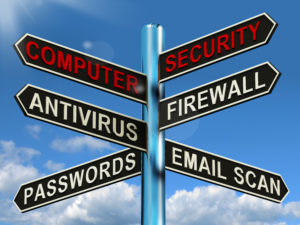 As one who manages way too many online accounts, I read this article from Ask a Tech Teacher contributor and CyberSecurity expert (retired), Sam Bocetta with interest. My checklist (green for good and red for ‘need help’):
As one who manages way too many online accounts, I read this article from Ask a Tech Teacher contributor and CyberSecurity expert (retired), Sam Bocetta with interest. My checklist (green for good and red for ‘need help’):
-
- I’m paranoid about links and downloads
- I check for virus and malware regularly
- Ooops–don’t yet use a VPN
- I should pay more attention to my passwords
- I am religiously careful of email
- Yep–switched to HTTPS for my blogs and websites
- I update software when prompted (that’ll have to be black)
Read Sam’s article below. When you’re done, evaluate your cybersecurity safety.
***
The topic of cybersecurity is becoming something people of all ages worry about. This is largely due in part to the rise in malware, ransomware, and infections people have experienced over the last year.
And these security threats aren’t just aimed at large businesses or municipalities, but normal people as well. Anyone who enjoys using the internet is a potential victim of hackers or malicious actors. And while most are aware that cyber-threats exist, most don’t know what to do about it.
This largely stems from the complexity of the subject and the challenge of teaching basic cybersecurity measures to everyday people. This is beyond concerning as cybersecurity is fast becoming one of the biggest threats to modern society. So today we are going to explain how to teach & outline cybersecurity best practices for both the young and old alike.
For many adults and parents, it can be a difficult task to teach the basic of staying safe online to those who are younger. However, the best strategy is starting conversations at an early age. This advice will be timeless as kids are starting to use the internet at younger and younger ages.
Harmful Links
Teach kids that not all links are created equally and that some can even be malicious. It’s a complicated subject for some to wrap their head around. After all, a link is just a link on the surface. So you will need to explain that some links could be harmful to click on.
A good way to teach this is to have them hover the cursor on the link and see the URL that it is pointed to. Let them know that if the URL isn’t one they recognize they should not click on it. If they are unsure, they should ask an adult.
Virus & Malware

Explain what a virus and what malware is. This can be a difficult concept for some younger people as it’s a very abstract topic. A simple way to explain this to them is Malware or Viruses take over a computer without approval from the user.
And that this could possibly lead to the computer no longer working, or being as fast. This can also lead to larger issues such as the company you get internet from disconnecting your service.
Suspicious Downloads
Even if its a “game they want to play” you have to instill the required reasoning so children can verify the website they are downloading from is trusted. A great way to teach younger people about this is to install a due diligence process.
This means having them do an online search for either the file name they are downloading or the website they are downloading it from. Also, by outlining the sites that are safe to download from, you can have them avoid suspicious downloads all together.
Utilizing A VPN
Easily one of the best ways to make your connection more secure and private when connecting to a public Wi-Fi will be to use a Virtual Private Network, or VPN. To put it in other words, a VPN will establish a virtual private communication channel over a non-private network, thus giving you an extra layer of security
Learning about the importance of a VPN and how to use one is something that anybody who uses public Wi-Fi often should know.
Strong Passwords
One of the most common things people do wrong when interacting with online programs or software is picking an easy or short password. To teach strong password basics to both young and old alike, explain why they are bad.
Let them know that hackers or malicious actors use programs that try lots of passwords, and that easy single word passwords will be cracked very easily. You can also teach the importance of using professional password manager services, which will not only only select passwords for your accounts that are incredibly tough for hackers to crack, but will also change those passwords on a weekly or daily basis for extra security.
Best Email Practices
For many older people using the internet, e-mail is their gateway to communicate with their friends or family. But a common pitfall is clicking on links from email addresses they do not recognize.
And what’s more, beyond simply opening emails, older email users are more likely to click on links in those emails. Teaching older internet users to not trust emails from people they don’t recognize will go a long long way to keeping them safe.
HTTPS > HTTP When Providing Information Online
Explain the difference between HTTP & HTTPS websites. This is a common area of confusion for some older internet users. You should explain that they should never under any circumstances submit personal, sensitive, or financial information on sites that do not have “HTTPS” present in the URL.
A great way to explain this is to advise any website asking for any information at all should be secure, and they should look for a lock icon next to the web address in their browser.
Using Antivirus Programs
Keeping your computer clear of viruses are a great way to ensure the worst doesn’t happen. It’s a common occurrence that when older people get their computer services that it’s full of hundreds of viruses.
Simply teaching them how to use the anti-virus software can go a long way. If possible, find a solution that automatically scans the machine at regular intervals and explain to them why regular check-ups are needed.
And while some interfaces are confusing when dealing with anti-virus software, a few minutes of training will have even the oldest of internet users get comfortable with the program. Said another way, spending a little bit of time to make them feel comfortable will help increase their buy-in.
Update Software
Many people both young and old alike may not update software on their computer or devices when it pops up. This is usually the case because they do not know the outcome of the update. However, to teach solid cybersecurity fundamentals you need to get across that these updates often contain improvements on security.
It’s a strange concept to explain that there are new type of exploits or holes in a device or software being found all the time. So explain to them that there are people out there constantly coming up with new ways to hack into devices and software.
Final Thoughts
It’s a fact of modern life that both the young and old have to use the internet to interact with society. But, these groups can be at a disadvantage due to the complexity of the subject. By simply teaching them some basics you can improve their security and confidence leading to a better overall experience.
While it is impossible to protect others or yourself from every risk, teaching the basics in a straightforward and understandable way will go a very very long way.
—Sam Bocetta is a retired cybersecurity analyst currently reporting on trends in cryptography and cybercrime
More on security
Use BCC to Hide Email Addresses
6 Tips to Avoid Email Phishing
10 Passwords Everyone Uses (And You Shouldn’t)
Jacqui Murray has been teaching K-18 technology for 30 years. She is the editor/author of over a hundred tech ed resources including a K-12 technology curriculum, K-8 keyboard curriculum, K-8 Digital Citizenship curriculum. She is an adjunct professor in tech ed, Master Teacher, webmaster for four blogs, an Amazon Vine Voice, CSTA presentation reviewer, freelance journalist on tech ed topics, contributor to NEA Today, and author of the tech thrillers, To Hunt a Sub and Twenty-four Days. You can find her resources at Structured Learning.




































